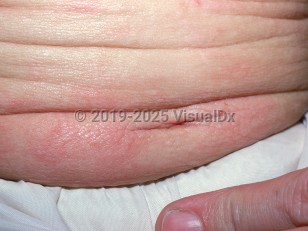Diffuse cutaneous mastocytosis in Child
Alerts and Notices
Important News & Links
Synopsis

Diffuse cutaneous mastocytosis (DCM) is a rare form of cutaneous mastocytosis that occurs in the pediatric population and is characterized by an abnormal accumulation of mast cells within the dermis. Unlike other forms of cutaneous mastocytosis, DCM generally involves the entire skin and frequently results in more severe disease phenotypes. DCM typically presents within the first 2-6 months of life, but it may be present at birth.
The clinical presentation may be variable. A distinctive presentation in infants is that of generalized bullae formation with underlying normal or erythrodermic skin. Another presentation in infancy is that of infiltrated papules and plaques with a "grained leather" appearance on which smaller vesicles can occur. Here, blistering is less severe and a less consistent feature. Features common to both these presentations include Darier sign, dermographism, flushing, and pruritus. In older children and teenagers, the appearance is variable and may include diffuse infiltration and/or hyperpigmentation, nodular mastocytomas, and pseudoxanthomatous lesions.
While the disease is generally limited to the skin, massive cutaneous mast cell degranulation often results in systemic side effects. Gastrointestinal symptoms are common, including poor feeding, diarrhea, and, rarely, upper gastrointestinal bleeding. DCM patients are at high risk for anaphylaxis, which may be triggered by a variety of stimuli including vomiting, change in temperature, or flares of cutaneous disease.
Blistering disease generally resolves between ages 3 and 5 years. Unlike adult forms of mastocytosis, DCM is generally self-limiting, and patients experience complete resolution between ages 10 and 13 years. A small subset of patients has germline mutations resulting in a familial form of DCM, which may have a more protracted course. Blistering lesions in these patients may resolve; however, they often continue to have other cutaneous features of DCM through adolescence and into adulthood.
The clinical presentation may be variable. A distinctive presentation in infants is that of generalized bullae formation with underlying normal or erythrodermic skin. Another presentation in infancy is that of infiltrated papules and plaques with a "grained leather" appearance on which smaller vesicles can occur. Here, blistering is less severe and a less consistent feature. Features common to both these presentations include Darier sign, dermographism, flushing, and pruritus. In older children and teenagers, the appearance is variable and may include diffuse infiltration and/or hyperpigmentation, nodular mastocytomas, and pseudoxanthomatous lesions.
While the disease is generally limited to the skin, massive cutaneous mast cell degranulation often results in systemic side effects. Gastrointestinal symptoms are common, including poor feeding, diarrhea, and, rarely, upper gastrointestinal bleeding. DCM patients are at high risk for anaphylaxis, which may be triggered by a variety of stimuli including vomiting, change in temperature, or flares of cutaneous disease.
Blistering disease generally resolves between ages 3 and 5 years. Unlike adult forms of mastocytosis, DCM is generally self-limiting, and patients experience complete resolution between ages 10 and 13 years. A small subset of patients has germline mutations resulting in a familial form of DCM, which may have a more protracted course. Blistering lesions in these patients may resolve; however, they often continue to have other cutaneous features of DCM through adolescence and into adulthood.
Codes
ICD10CM:
Q82.2 – Mastocytosis
SNOMEDCT:
703826004 – Diffuse cutaneous mastocytosis
Q82.2 – Mastocytosis
SNOMEDCT:
703826004 – Diffuse cutaneous mastocytosis
Look For
Subscription Required
Diagnostic Pearls
Subscription Required
Differential Diagnosis & Pitfalls

To perform a comparison, select diagnoses from the classic differential
Subscription Required
Best Tests
Subscription Required
Management Pearls
Subscription Required
Therapy
Subscription Required
References
Subscription Required
Last Reviewed:11/21/2017
Last Updated:08/12/2024
Last Updated:08/12/2024
Diffuse cutaneous mastocytosis in Child

